The Friends of the Wildflower Garden, Inc.
Plants of the Eloise Butler Wildflower Garden
The oldest public wildflower garden in the United States
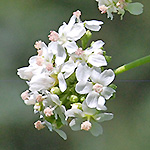
Common Name
Glade Mallow
Scientific Name
Napaea dioica L.
Plant Family
Mallow (Malvaceae)
Garden Location
Upland
Prime Season
Early to Late Summer Flowering
Glade Mallow is an endangered native erect perennial forb growing on stout stems to 6+ feet high, with occasional branching in the upper section. Stems are green, ridged and with sparse fine hair.
The leaves are alternate and huge, 4 to 12 inches long and across, somewhat round in outline with 5 to 9 deep palmate lobes which are coarsely toothed with an under-surface that has fine hair with longer hair on the main ribs. All but the very upper leaves are on long stalks. Upper leaves are sessile. At the base of the leaf stalk are a pair of lanceolate shaped leaf-like stipules which wither away as the plant matures. These are quite large as stipules go.
The inflorescence is a panicle of stalked clusters atop the stem. Each cluster sub-branches into smaller segments. These can be quite large and quite dense.
Flowers: Glade Mallow is dioecious - that is - the male and female flowers are on separate plants. The calyx has a short tubular shape with five outward flaring pointed green lobes while the corolla has 5 white deeply cut spreading lobes (petals). The corolla lobes are oblong, with rounded tips (sometimes pointed). Calyx lobes and flower stalks have sparse fine hair. The open flower ranges from 1/3 to 1/2 inches across. The male flowers have numerous stamens, united at their bases, with short filaments separating only just below the yellowish-tan anthers. These are exserted well beyond the lobes of the corolla. The base of the stamens inside the corolla has whitish hair. Female flowers have an exserted pistil with a 6 to 10 branched style.
Seed: Fertile flowers produce a globular dark brown seed head with a depressed top that splits into 6 to 10 one-seeded flattened wedge or kidney shaped sections (mericarps), each seed about 5 mm long. Seeds require 60 days of cold stratification for germination.
Habitat: Glade Mallow grows from a large, corky, branching taproot. It may grow in full sun to partial shade in woodland opening. Plants in full shade will not be robust. In all cases the plant requires wet-mesic to mesic soil moisture. In the wild it is usually found along stream edges.
Names: The genus Napaea is said to come from the word 'nape' for 'of the glade'. It is also said to be from the Greek napaea for a wood nymph - both meanings would refer to a woodland setting. The species dioica refers to 'dioecious' - with the sexes on separate plants. The author name for the plant classification, 'L.', is for Carl Linnaeus (1707-1778), Swedish botanist and the developer of the binomial nomenclature of modern taxonomy.
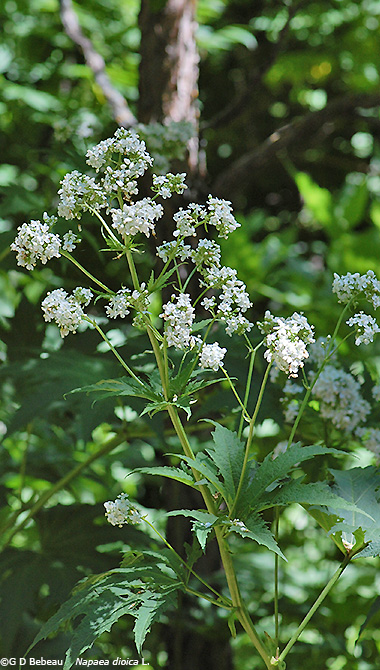
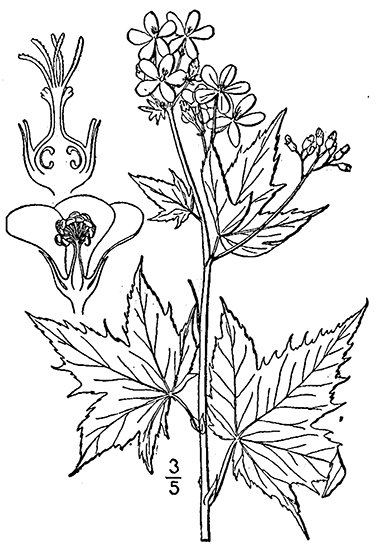
Above: The inflorescence of Glade Mallow with its many branched clusters. Drawing from Britton, N.L., and A. Brown. 1913. An illustrated flora of the northern United States, Canada and the British Possessions. 3 vols. Charles Scribner's Sons, New York.
Below: 1st photo - The stalked clusters of the inflorescence can be many and very densely filled with flowers. 2nd photo - Male flowers - sexes are on separate plants.


Below: 1st photo - Female flower - has an exserted pistil with a 5-part style. 2nd photo - The green calyx has some fine hair and 5 pointed triangular lobes.
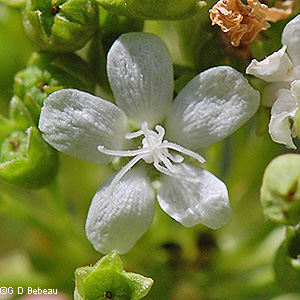
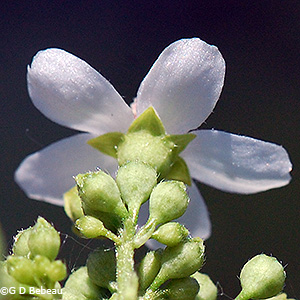
Below: 1st photo - The palmately divided leaf can have 5 to 9 lobes, each lobe with some coarse teeth. 2nd photo - The underside of the leaf has a fine vein pattern, much paler color due to very fine hair, and a few long whitish hair on the main ribs.
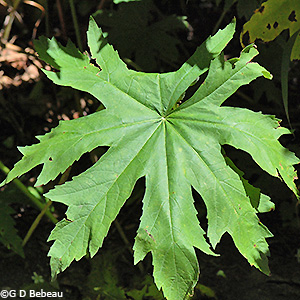

Below: 1st photo - The mature seed head showing the seed divisions. 2nd photo - Individual seeds are wedge shaped with small ribs on the outer circumference.
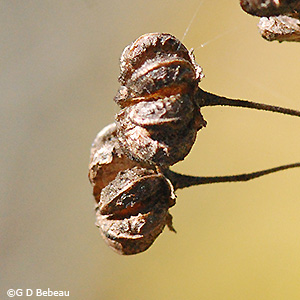
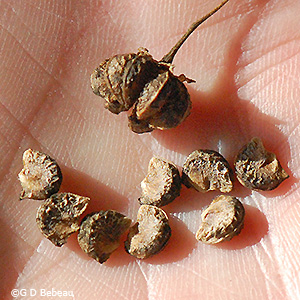
Below: 1st photo - At the base of each branch of the inflorescence are several linear pointed bracts. One of the mature female flowers has started to produce the seeds - you can see the flattened, vertically segmented green seed capsule. 2nd photo - At the base of each leaf are a pair of lanceolate shaped stipules, quite large; these wither away as the plant matures - 3rd photo.
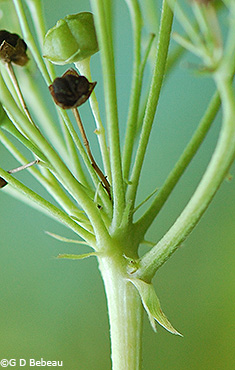
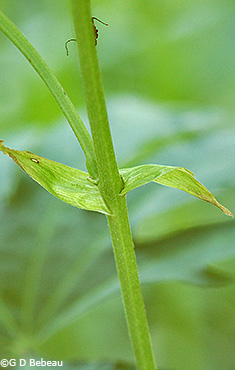

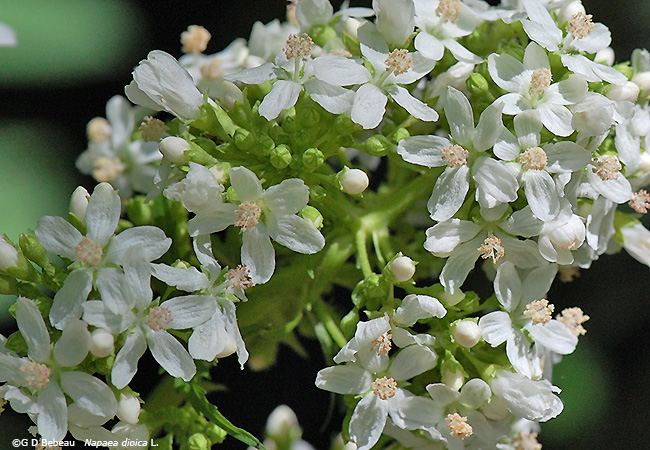
Notes: The Minnesota DNR notes that Glade Mallow is a very old species and is the only dioecious species of the Malvaceae family found in the western hemisphere. It is the only native species of Napaea found in Minnesota or Wisconsin. It has been in the Garden in recent years, showing up after a prairie restoration project.
Scarcity: Glade Mallow is found in Minnesota only in six counties in the SE corner of the state. Minnesota is at the NW extremity of its range. In North America it is found only in 8 states - Minnesota, Iowa, Illinois, Indiana, Ohio, Pennsylvania, Virginia, Vermont, Wisconsin and also in the District of Columbia. In Indiana it is considered rare, while it is on the 'threatened' list in Minnesota as it has only a few populations and the habitat is becoming more scarce, however, in Fillmore and Olmsted counties there are several large populations in the Root River area.
Return to -- Site Plan/Archive Index --or-- List of Common Plant Names -- or -- List of Scientific Names -- or --Home Page - - - Back to top.
References: Plant characteristics are generally from sources 1A, 32, W2, W3, W7 & W8 plus others as specifically applied. Distribution principally from W1, W2 and 28C. Planting history generally from 1, 4 & 4a. Other sources by specific reference. See Reference List for details.
 Identification booklet for most of the flowering forbs and small flowering shrubs of the Eloise Butler Wildflower Garden. Details Here.
Identification booklet for most of the flowering forbs and small flowering shrubs of the Eloise Butler Wildflower Garden. Details Here.
©2013
Friends of the Wildflower Garden, Inc. Text and photos are by G. D. Bebeau unless otherwise credited. "www.friendsofeloisebutler.org"
052220